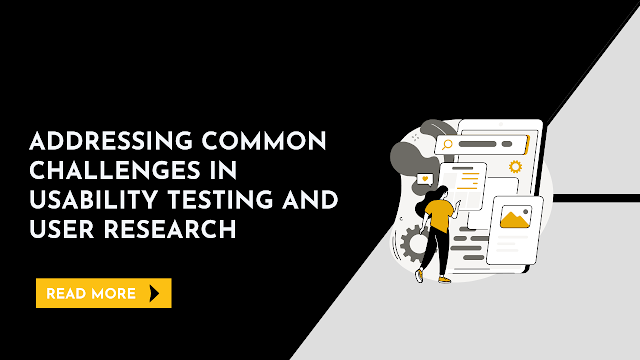Addressing Common Challenges in Usability Testing and User Research
Introduction:
In the ever-evolving landscape of digital products and services, the importance of usability testing and user research cannot be overstated. These processes are the bedrock of creating products that resonate with users, offering seamless experiences and intuitive interfaces. However, the journey of conducting usability testing and user research is not without its challenges.
In this blog, we'll explore some common obstacles faced by professionals in these domains and discuss strategies to address them effectively.
1. Recruitment Woes: Finding the Right Participants
One of the primary challenges in usability testing services are recruiting the right participants. Identifying individuals who represent the target audience can be a daunting task. Often, researchers struggle to reach a diverse and representative sample that mirrors the actual user base.
Solution:
Define Clear Personas: Start by creating detailed user personas that represent your target audience. This will guide the recruitment process and help in identifying individuals who match the characteristics of your ideal users.
Utilize Recruitment Platforms: Leverage online platforms dedicated to participant recruitment. These platforms often have a pool of diverse participants willing to take part in usability testing.
Incentivize Participation: Offer incentives to participants, such as gift cards or discounts, to increase motivation and ensure a higher response rate.
2. Budget Constraints: Doing More with Less
Usability testing and user research often face budget constraints, especially in smaller organizations or startups. Limited resources can hinder the ability to conduct extensive research and gather comprehensive insights.
Solution:
Prioritize Research Goals: Clearly define your research goals and prioritize areas that are critical to the success of the product. Focus on gathering insights that directly impact user experience and product usability.
Explore Affordable Tools: Utilize cost-effective tools and platforms for conducting remote usability testing and surveys. Many tools offer free or trial versions that can be sufficient for smaller projects.
Consider DIY Approaches: Empower your team with the skills and knowledge to conduct some aspects of usability testing internally. DIY usability testing kits and guides are available, allowing for in-house testing on a budget.
3. Time Constraints: Racing Against the Clock
In the fast-paced world of product development, time is often of the essence. Usability testing and user research can become casualties of tight schedules, leading to rushed processes and incomplete insights.
Solution:
Implement Agile Methodologies: Integrate usability testing and user research into agile development processes. Conduct iterative testing throughout the development lifecycle, allowing for continuous improvement based on user feedback.
Opt for Rapid Prototyping: Use rapid prototyping techniques to quickly create and test design concepts. This approach facilitates early user feedback without elongating the design phase.
Prioritize Critical Phases: Identify critical phases in the development cycle where usability testing and user research can have the most significant impact. Allocate time and resources accordingly to ensure these phases are thoroughly covered.
4. Remote Testing Challenges: Bridging the Gap
With the rise of remote work, conducting usability testing and user research remotely has become increasingly common. However, remote testing comes with its own set of challenges, including issues with technology, communication, and participant engagement.
Solution:
Invest in User-Friendly Tools: Choose remote testing tools that are user-friendly and accessible to participants. Ensure that the technology doesn't create barriers for users who might not be tech-savvy.
Provide Clear Instructions: Clearly communicate instructions to participants, emphasizing the importance of a distraction-free environment and a stable internet connection. Offer technical support if needed.
Enhance Communication: Use video conferencing tools to establish a more personal connection with remote participants. Encourage open communication and provide opportunities for participants to ask questions or seek clarification.
5. Analysis Paralysis: Making Sense of Data Overload
Collecting vast amounts of data through usability testing and user research is valuable, but it can lead to analysis paralysis. Sorting through the data and distilling meaningful insights can be overwhelming.
Solution:
Set Clear Objectives: Establish specific research objectives before conducting tests. This will guide the data collection process and help in focusing on relevant insights.
Use Data Visualization Tools: Leverage data visualization tools to represent findings in a clear and digestible format. Visual aids such as charts, graphs, and heatmaps can simplify complex information.
Collaborate and Iterate: Foster collaboration among team members during the analysis phase. Conduct iterative analysis sessions, allowing team members to share perspectives and collectively make sense of the data.
6. Overcoming Biases: Unveiling Unconscious Influences
Biases, both conscious and unconscious, can impact the outcomes of usability testing and user research. Researchers may inadvertently influence participants, leading to skewed results.
Solution:
Diverse Research Teams: Build diverse research teams to bring different perspectives to the table. This can help in identifying and mitigating biases during the planning and analysis stages.
Use Neutral Language: During usability testing sessions, use neutral language and avoid leading questions that may inadvertently guide participants. Encourage participants to provide honest and unbiased feedback.
Constantly Reflect and Learn: Regularly reflect on your research methodologies and outcomes. Embrace a culture of continuous learning, where researchers are open to recognizing and addressing biases for ongoing improvement.
Conclusion
Quality Assurance Testing and user research are invaluable tools for creating user-centric products and experiences. While challenges may arise, addressing them proactively ensures that the insights gained are robust and actionable. By refining recruitment strategies, optimizing resources, embracing remote testing, streamlining analysis processes, and fostering a bias-aware culture, organizations can navigate the complexities of usability testing and user research successfully. As technology continues to advance, these practices will remain essential in creating products that not only meet user expectations but exceed them.

.jpg)


Comments
Post a Comment